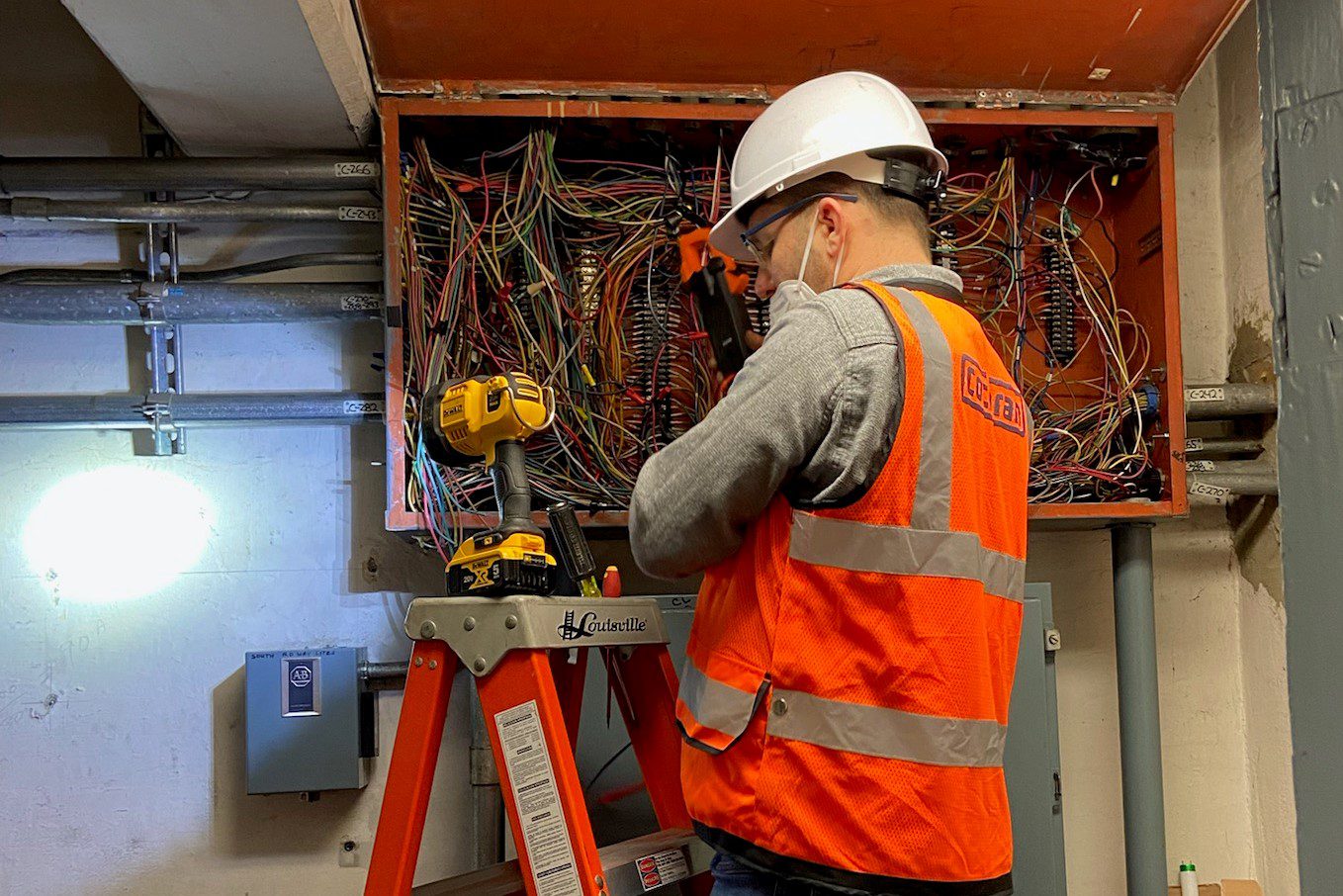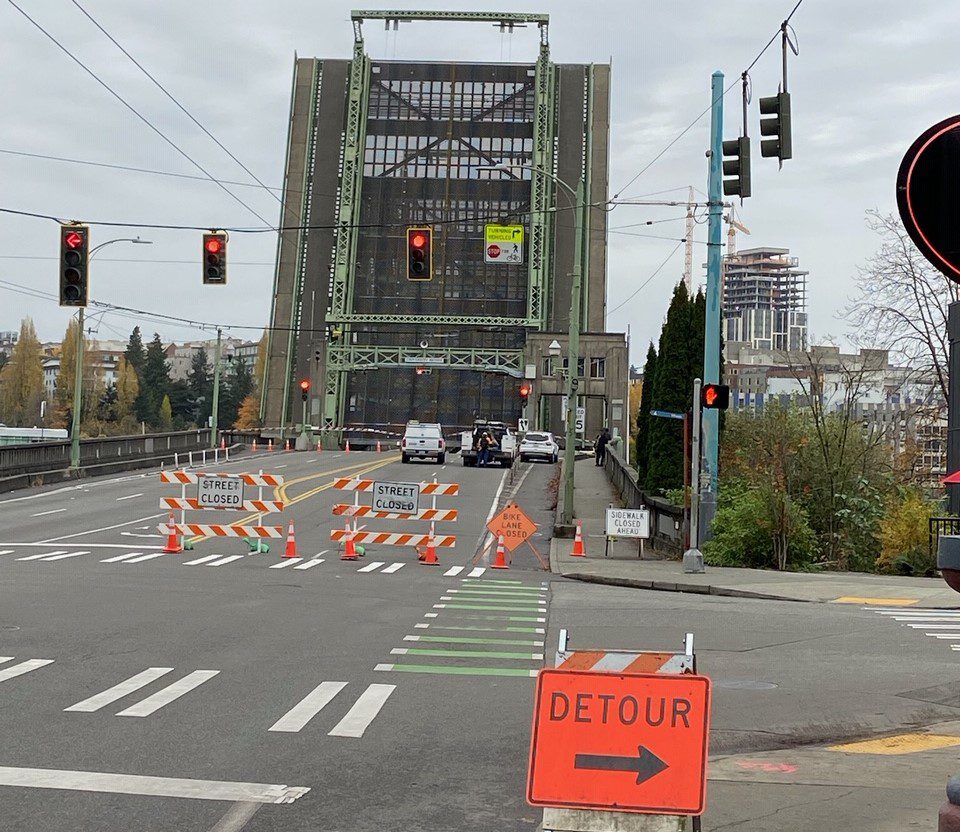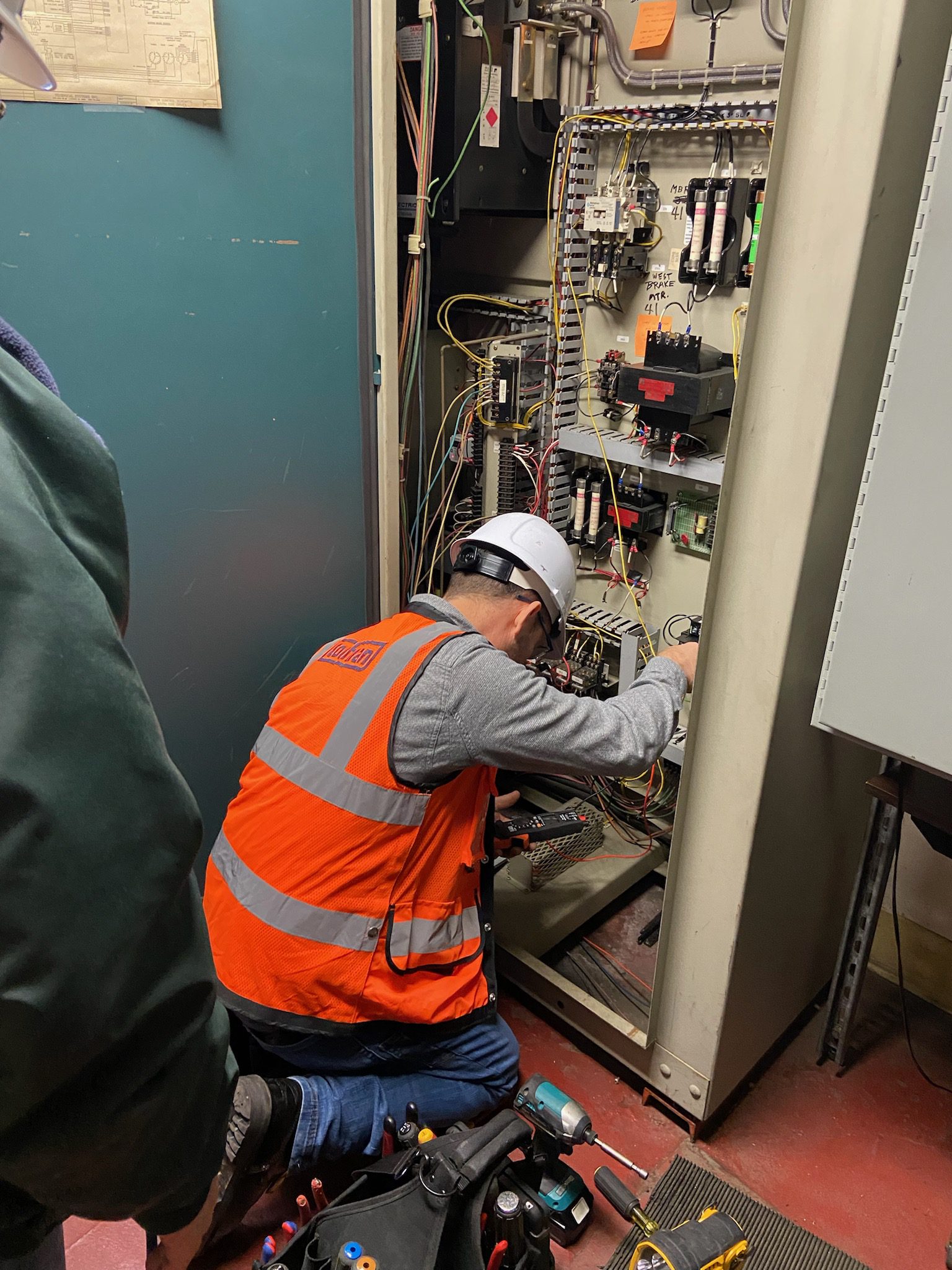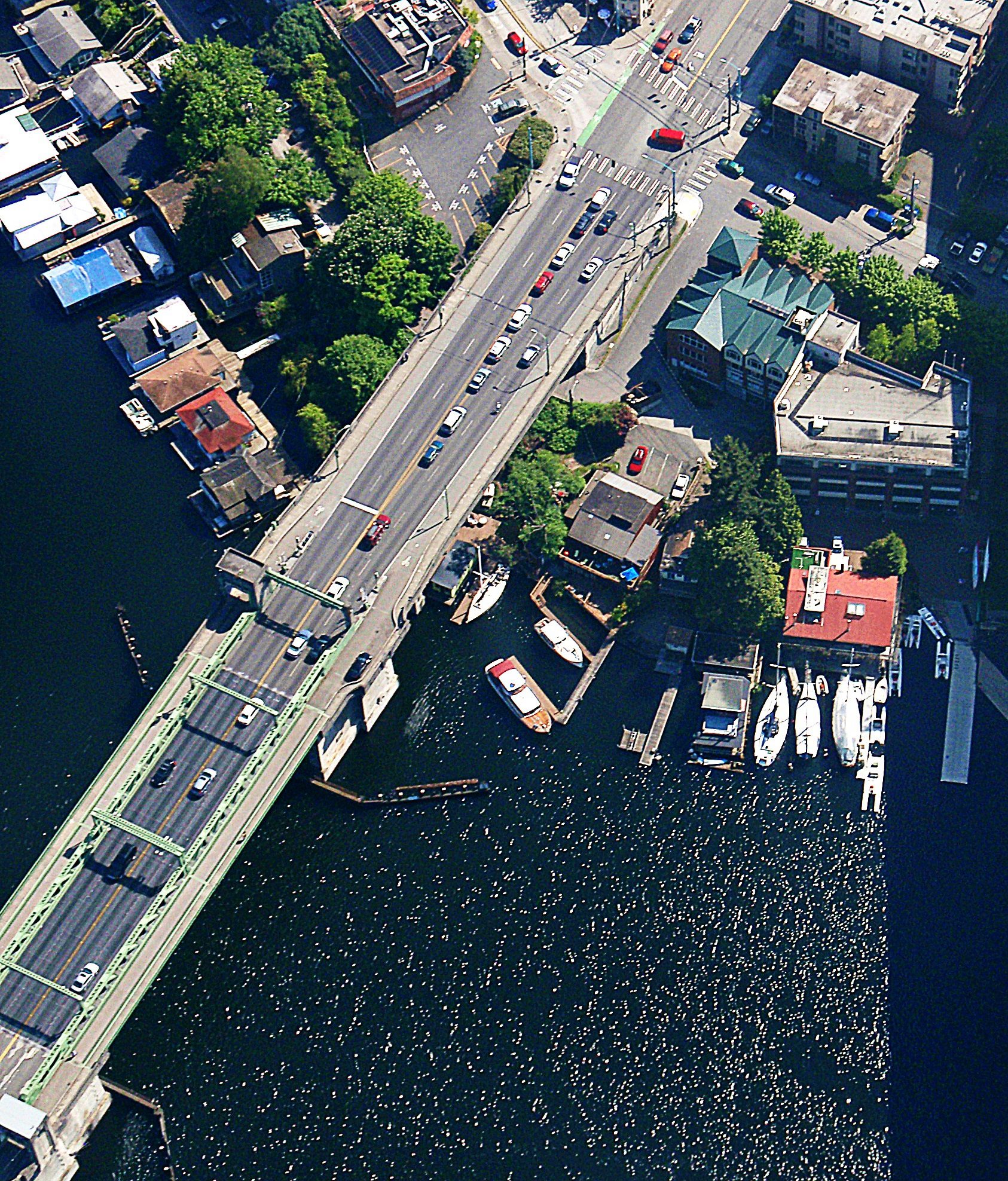 An engineer works to diagnose and repair bridge electrical systems. Photo: SDOT
An engineer works to diagnose and repair bridge electrical systems. Photo: SDOT Summary:
- Maintaining a transportation system that reliably connects people to where they need to go is one of our primary goals. After an electrical malfunction required the closure of the University Bridge on Friday, November 12, our crews worked that day and throughout the weekend to safely reopen the bridge as quickly as possible, once the underlying issue had been resolved and new electrical equipment had been installed. The bridge was fully reopened on Sunday morning, November 14.
- The University Bridge is a critical piece of our transportation system for all modes of travel, and we recognize the inconvenience of the bridge being closed, even temporarily, particularly for community members who live and work in adjacent neighborhoods. We communicated timely updates to our partners and the traveling public to help increase awareness, avoid confusion, and confirm when the bridge was reopened.
- We also worked to manage traffic and provide alternate routes, with the highest traffic volumes occurring during the UW football and Seattle Kraken hockey events on Saturday evening (November 13). During the closure, we encouraged people to take advantage of investments in Link light rail, bus service, and biking infrastructure to reduce congestion.
- The primary cause of the closure was a malfunction in the electrical systems of the 102-year-old bridge. The issue had not arisen before, and it took time to diagnose and fix it.
- We are looking ahead to additional work in 2022 to preserve and maintain our bridge structures into the future, including implementing lessons learned from this emergency closure moving forward.
Investments to extend Link light rail in North Seattle, provide walking and biking access to the new light rail stations, and maintain reliable bus service gave people viable alternatives to driving and helped manage traffic near the bridge while it was closed. This was especially important to help minimize impacts to people who live and work in adjacent neighborhoods, bearing the greatest brunt of the closure.
Over the weekend of November 12-14, the University Bridge became stuck open for nearly 48 hours due to an electrical system malfunction that occurred on the morning of Friday, November 12.
Our roadway structures crews, bridge operators, and engineers worked tirelessly throughout the weekend to assess the issue, identify the root cause, obtain electrical parts needed to safely reopen, and install them. Concurrently, we placed detour signs for local travelers, worked with transit agency partners to reroute transit services in the area, and communicated to the public via our blog, social media, and press releases.
On a normal day, the University Bridge is vital link in our transportation system, carrying tens of thousands of people riding the bus and driving vehicles, as well as and hundreds of people walking, rolling, and riding their bikes. This closure overlapped with a UW football home game and a Seattle Kraken hockey game at the Climate Pledge Arena on Saturday evening, so our communications and traffic detour efforts considered the needs of people traveling to those events, as well as local community members living and working near the bridge who frequently depend on the bridge to get around. We recognize the impact the unplanned closure had on people’s ability to travel in the area and destinations further to the south and north.
The University Bridge was closed to people walking, biking, rolling, and driving while it was stuck in an upright position and until the bridge’s systems were adequately addressed, and necessary repairs were completed so we could ensure a safe reopening. Crews and engineers brought power back to the bridge and after several tests of the bridge opening systems, SDOT reopened the bridge to travelers on Sunday morning at around 9:40 a.m. We are committed to transparency and clear communication with the public, and this post is a follow-up, now that we have had a short time to review and reflect on the incident.

The primary cause of the closure was a malfunction in the electrical systems of the 102-year-old University Bridge. The issue had not arisen before, and it took time to diagnose and fix it.
SDOT’s Roadway Structures team regularly conducts routine and preventative maintenance on all of our bridge systems. On Friday morning during an opening, the South span of the bridge experienced an electrical failure. The North span of the bridge houses the bridge operator and the main control system, adding to the complexity of identifying and repairing the issue. Immediately after the electrical failure, our team, including electricians, engineers, bridge operators, and emergency support from controls electrician Cochran Electrical worked together to:
- Confirm the root cause of a ‘fault to ground’ in parts of the far side motor control system.
- Find needed replacement parts on an emergency basis, after-hours, from several commercial electrical supply companies.
- Diagnose other overall bridge control system problems that were caused by the initial component failure.
- Trace closed-loop circuit wiring, which required access to several circuit node areas, covering a few hundred feet of conduit throughout the bridge.
Through this work, we ultimately found that a faulty relay caused the short and had overloaded the electrical power transformer. Again, once these issues had all been safely and satisfactorily addressed, the bridge was reopened on Sunday morning (November 14). Now that we have returned the bridge to full operations, we are continuing to check all of the electrical systems to confirm that they are not showing residual damage, and we will continue to replace electrical system components as necessary.

We are looking ahead to additional work in 2022 to preserve and maintain our bridge structures into the future, including implementing lessons learned from this emergency closure.
Mayor Durkan’s proposed 2022 budget, currently under consideration by the Seattle City Council, funds additional work to prioritize important preservation and maintenance work on the many bridges and structures that we manage. It includes an addition of $3 million in new capital funding for replacement of mechanical and electrical components on three of the City’s moveable bridges (University, Ballard, and Spokane St Swing), plus an additional $2.25 million for rehabilitation work on the 4th Avenue South Bridge.
The 2022 proposed budget also allocates $1.9 million to funding an overall effort to update our inspection, maintenance, and asset management practices and priorities. This effort, which we call the “Business Practices Update,” will have dedicated staff and consultant support and will give us a clear and deliverable plan for how we continue investments in all of our bridges to ensure reliability and safety for the traveling public. We plan to continue to grow our capabilities to put resources to use with the right interventions at the right time.
We are applying the lessons learned from this University Bridge closure to help determine if other bridges across the city could experience any similar issues, as part of our ongoing efforts to continually improve and strengthen our bridge maintenance and preservation processes.
Through the Business Practices Update, we will:
- Shift bridge maintenance programming and execution from response-based asset maintenance to proactive asset preservation (continuing an already-underway effort).
- Use the condition of specific bridge components (including movable bridges and other bridges that SDOT owns and maintains), rather than an averaged rating for each overall structure.
- Document the determined cause of any unplanned bridge closures or outages, and using those lessoned learned and experiences to avoid similar outages in the future (both at the specific bridge affected and at other similar bridges within the SDOT’s managed bridge and structure assets, as applicable).
- Use gained knowledge to continually assess and improve internal preventive maintenance and management processes, as well as identify ways to be further prepared or adjust the process to help increase readiness.
Our team works year-round to frequently and proactively preserve and maintain our bridge structures across the city, in order to help keep the public moving safely and reliably. This work is critical and helps to support our central agency mission, vision, values, and goals.
Check out some of the ways we make this a priority every day in this blog post from last month.
